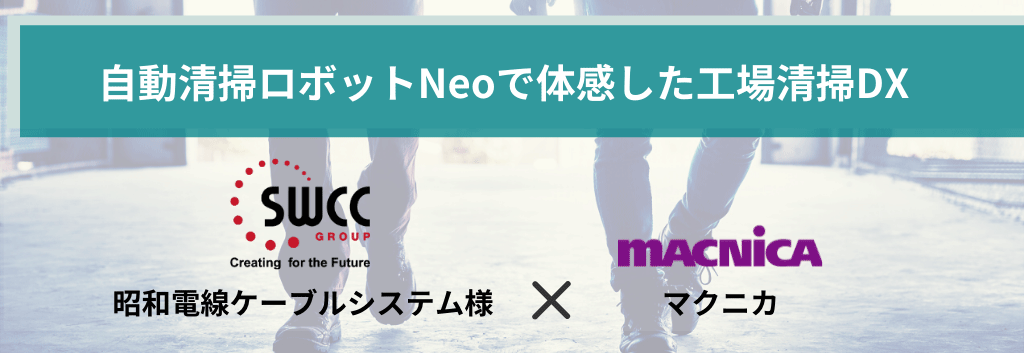
SWCC SHOWA CABLE SYSTEMS CO.,LTD., Ltd. was established in 2006, and has expanded its business centered on the production and development of electric wires and cables for all fields, including mobility and healthcare, in addition to construction.
Counting from our predecessor Showa Densen Densen Co., Ltd., we have been providing high-quality seismic isolation materials, precision devices, electric wires and communication cables to all industries in Japan for more than 80 years.
Currently, it is mainly responsible for everything from sales of the communication and energy system business to technology development, procurement of materials, and manufacturing, and supports Japan's social infrastructure from the ground up.
"Although it wasn't an urgent issue, the introduction of the automatic cleaning robot 'Neo' was very beneficial as an initiative for the future." Mr. Mineo Matsuzaki, Manufacturing Group, Power Cable Section, Power System Department.
This time, we interviewed him about the history of the introduction of Neo and the benefits after the introduction.
(This article is a reprint of the webinar held on February 22, 2022)
An automatic cleaning robot as a solution to future issues
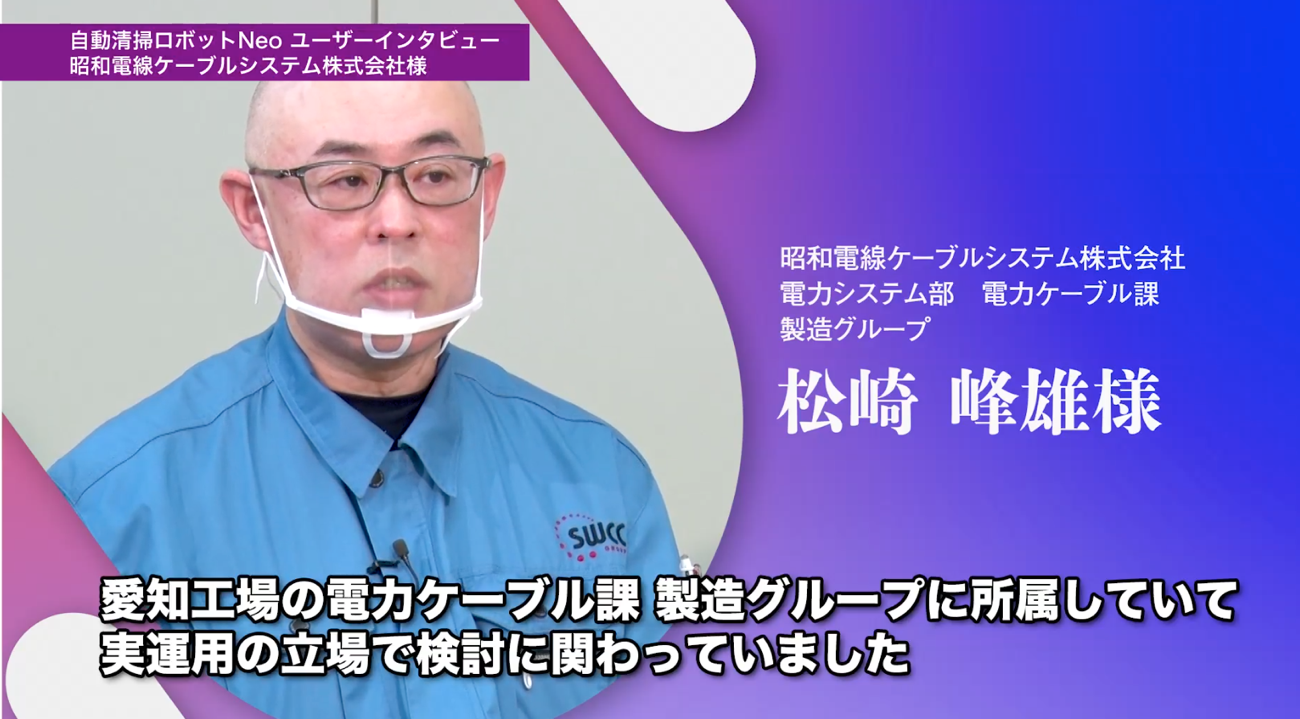
Mr. Matsuzaki: ``Our company focused on automatic cleaning robots because, in addition to the cost benefits of saving labor in cleaning work, we also felt that they could be part of efforts to reform work styles, so we decided to seriously consider them.'' I decided to do it.”
The Showa Electric Wire CS Aichi Factory, which the company planned to use, has a total area of 55,000 square meters, which is the same size as Tokyo Dome.
Macnica 's automatic cleaning robots have a wealth of experience in warehouses, train stations, airports, and hotels, but in the case of factories, the same problem as in warehouses is that the line of movement is subject to change.
In addition, there are cases where the workpiece is always covered with dust and must be removed before starting work.
In addition, on the factory side, due to the COVID-19, there were restrictions on coming to work, and it was necessary for a small number of people to handle work that could not be replaced by remote work, such as production and clerical work, as well as cleaning.
Against this backdrop, Hironao Ito, General Manager of Procurement Planning in the Procurement Department of the company, said, "I thought that the introduction of an automatic cleaning robot would be a very valuable initiative from the perspective of ESG and SDGs."
``I don't think anyone wants to do cleaning in the first place,'' says Mr. Ito, who places particular emphasis on job satisfaction and the SDGs.
The aim was to create an environment in which employees can concentrate on their original work and find it rewarding to work, and to create a foundation for more efficient use of water resources, which will become an international issue in the future.
Mr. Ito: "It may be a small thing, but I think it's important for a company to continue to make efforts like this."
* In 2019, the Showa Densen SWCC Group Densen Cable Systems, was registered as a Kanagawa SDGs Partner. This partner program is an activity to promote the dissemination of SDGs through public-private partnership sponsored by Kanagawa Prefecture.
“Cleaning” is easy to realize DX, easy to use as a small opportunity
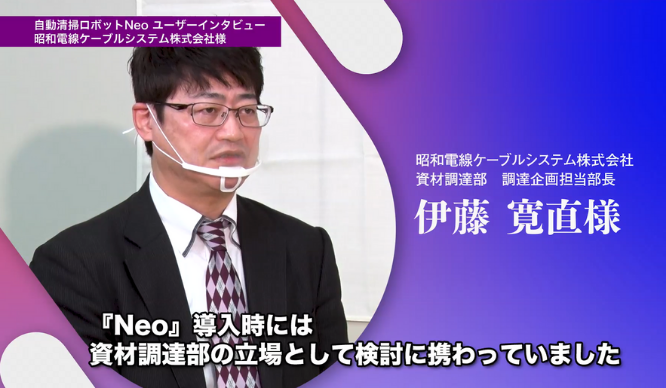
Mr. Matsuzaki: "There were two important points in terms of cost: the ability to reduce labor costs for cleaning, and the fact that we wanted to see results quickly, so we could feel the effects within a year or two."
Mr. Ito continues that the reason why he dared to mention that "the effect can be felt in one to two years" as an important point is largely due to the DX initiatives that the company as a whole is working on in various operations.
General Manager Ito:"DX requires a lot of time to change operations, and it tends to take a long time to get things running.
The most important issue this time was the reduction of labor costs for cleaning, and we thought that we would be able to realize the effect quickly and shorten the time until the problem was solved, so that the reduction effect would be large.”
Mr. Shotaro Miura, who is actually in charge of on-site operation, also introduced the selection criteria on-site.
Safety and operability, whether there will be collisions with equipment and materials, whether obstacles on the route can be avoided, and whether the burden on operators will increase compared to the current situation.
As mentioned above, it is a major premise that "the flow line is easy to change" in the factory, as well as the equipment and materials, as well as the obstacles, to prevent collisions and accidents.
Mr. Miura said that he carefully looked at the troubles of operators in operation and management, including collisions and accidents.
As a result of these considerations, it was determined that the introduction of an automatic cleaning robot would not require any major operational changes, and that it would be ``low difficulty to convert to DX,'' such as ``determining the area to be cleaned and what to do with the asymmetrical area.'' . We quickly moved to implement it.
However, when it was actually put into operation, a new problem emerged.
Re-examination of new issues that occurred during actual operation
Mr. Matsuzaki: ``I've come to realize that labor saving in the true sense of the word seems difficult.''
Depending on the type of cleaning, people may have to sweep up the trash. In terms of operation, Mr. Matsuzaki said, ``I expected too much from automatic cleaning robots,'' such as creating and adjusting route maps for automatic cleaning robots, which required additional effort and expense.
The company then searched again for an automatic cleaning robot that met their needs, and ended up finding Macnica 's Neo automatic cleaning robot, continued Ito.
Manager Ito: ``Honestly, at first I had the impression that it was a top-of-the-line product, but we were able to overcome all the issues that we felt were issues, and when we calculated the total cost including operational aspects, we realized that it was a product with great benefits. I judged it to be a valuable product and decided to install it."
With an additional brush that can also collect trash, a single machine can handle both sweeping and wiping, making it possible to achieve the initial goal of reducing labor costs.
Regarding the price, Mr. Matsuzaki continued, ``It was highly rated,'' as it was easy to calculate the ``appropriateness'' of the initial cost and running cost by calculating all kinds of numerical data, such as the required cleaning time.
3 days from product arrival to operation, "I can feel the effect"
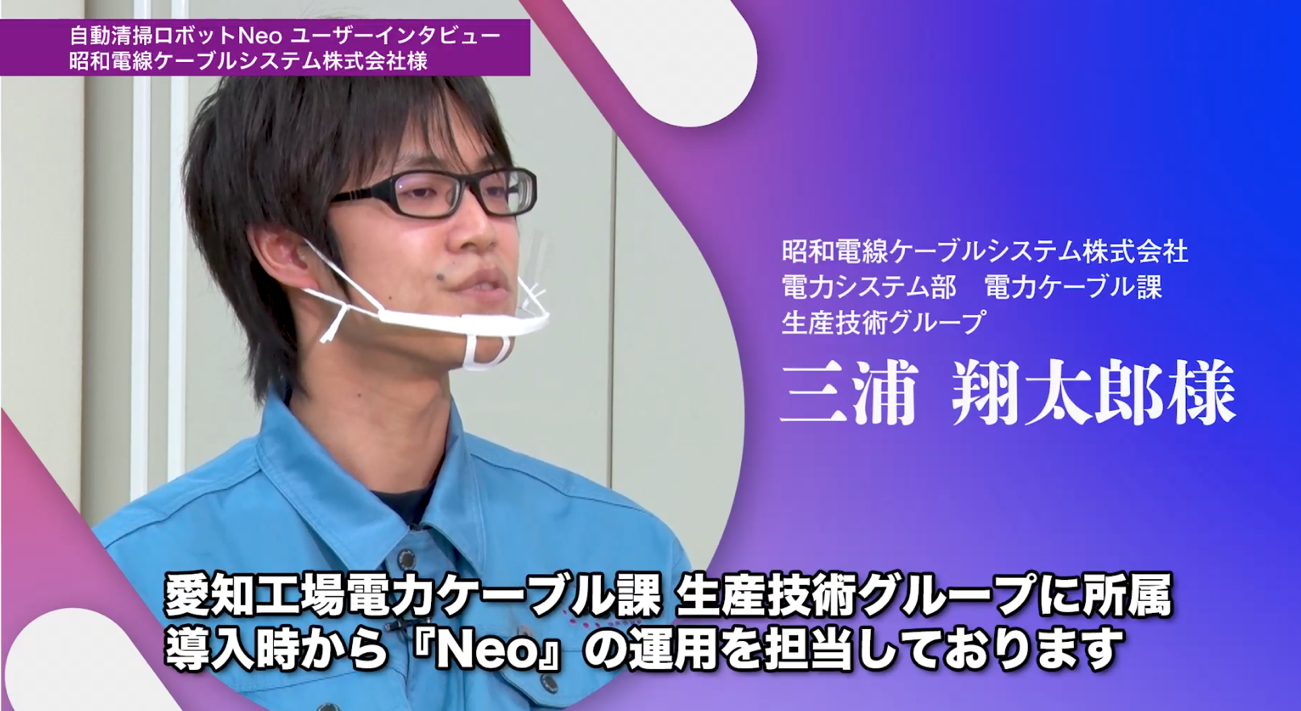
About three years after its introduction, three people nodded and said, "I can feel the effect."
Looking back on those days, Mr. Miura said, "I was shocked by the cleaning power from the first day."
Mr. Miura: "I was also surprised by the speed. The speed of the automatic cleaning robot directly leads to work productivity.
I was surprised that it was moving at the speed of a brisk walk. But the cleaning quality exceeds expectations.”
3 days from introduction to operation. The product arrived, the route map data was acquired by hand, and the map was created the next day. The number of personnel required for cleaning is reduced by 70%.
It used to be a 30-minute job once a week, but when it became the work of dozens of people, I was able to devote a considerable amount of time to my main work.
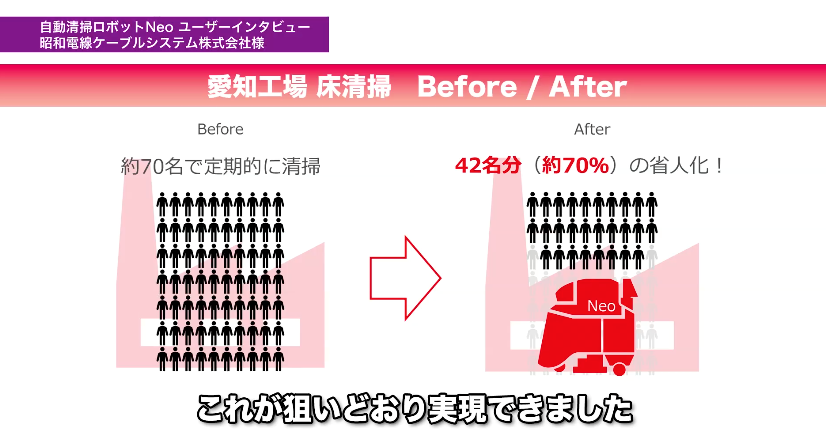
Mr. Miura: "I also heard that the awareness of 5S has increased. The aisles have become cleaner than before, so it seems that some employees are driving without leaving marks from the forklift tires."
In addition, even after Showa Densen Cable System introduced "Neo", the environment in the factory did not deteriorate due to the restrictions on employees coming to work, which was "a great point of satisfaction," he concluded.
Currently, based on the results of the Aichi factory, we are promoting the expansion to other offices and bases.
In addition, as part of the medium-term management plan's "transformation," it is one of the success stories of "using new technology to change familiar operations." speaks.
Mr. Ito: "Also, in considering social problem-solving businesses, Neo is a good match for one of our company's themes, 'Solving the labor shortage,' and we are thinking that it will be a hint for new businesses. increase"
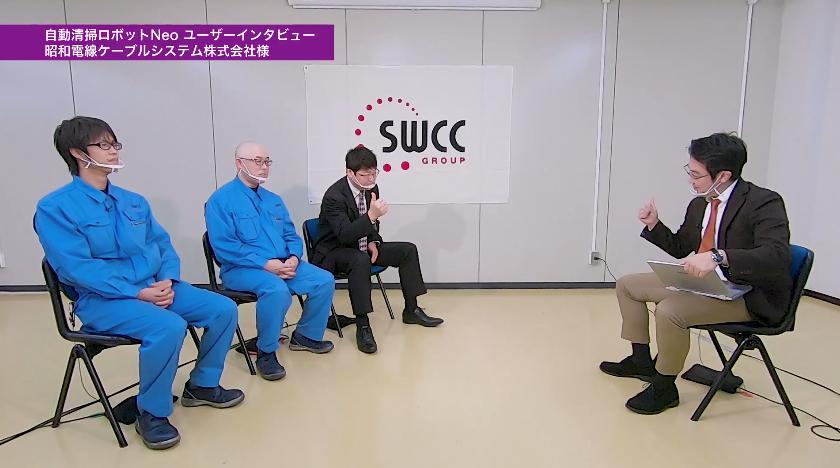
Finally, we asked about the considerations and key points for success when introducing and operating automatic cleaning robots.
Miura-san: "I think it's important to really think about how to clean it so that it looks nice.
In our company, if a robot can't do both sweeping and wiping, it can't be said to be clean. I think it's best to consider the advantages of each robot while keeping in mind that "no robot can do everything."
Mr. Matsuzaki: "Cleaning robots don't just run when you press a button. You have to carefully consider the effort and cost required to actually operate them."
Manager Ito: "The price will be high, but even if the price is reasonable, there is no point if it cannot be used or will not be used.
You need to consider whether it meets your company's objectives and is suitable for the factory environment. Macnica will make proposals based on that perspective, so it's a good idea to consult with them."
Case study
The following page introduces an introduction example of SWCC SHOWA CABLE SYSTEMS CO.,LTD., Ltd.
Please take a look.
